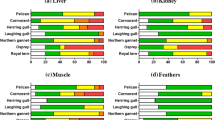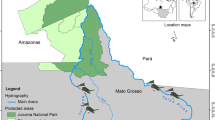Abstract
The Hara Mangrove Forest of the Persian Gulf is undergoing increasing pollution from industrial, municipal, and petroleum sources; however, little research in ecotoxicology has been carried out in this ecosystem. In the present study, mercury distribution and accumulation were investigated in muscle, liver, kidney, and feather of the resident Western reef heron (n = 15) and the migratory Siberian gull (n = 15). We also evaluated the relation between Hg concentrations, sex, and age (juvenile vs. adult). Results showed that the highest concentrations of Hg were recorded in the feather (35 ± 0.14–3.0 ± 0.27 mg kg−1 dw) and at 3.7-, 1.6-, and 1.3-fold in muscle, kidney, and liver, respectively. Concentrations of mercury in tissues of migratory birds were two times higher than in resident birds; geographical differences and feeding habits were used to explain these variations. We found a weak relationship between Hg concentrations in feathers and internal tissues (r ≤ 0.50); conversely, liver presented strong positive correlations with other soft tissues, especially kidney (p > 0.05; r = 0.82). Results showed that sex and age have no significant effects on T-Hg accumulation in these birds (p > 0.05; r < −0.01). Based on these findings, Hg concentrations were low in both species. Therefore, Hg contamination of this aquatic ecosystem is not a threat. Accordingly, we recommend the use of the Western reef heron as a bioindicator of mercury pollution in this region.



Similar content being viewed by others
References
Ackerman, J. T., Eagles-Smith, C. A., Takekawa, J. Y., Adelsbach, T. L., & Bluso, J. D. (2008). Mercury concentration in blood and feathers of prebreeding Forster’s terns in relation to space use of San Francisco Bay, California, USA, habitats. Environmental Toxicology, 27(4), 897–908.
Agusa, T., Matsumoto, T., Ikemoto, T., Anan, Y., Kubota, R., Yasunaga, G., & Shibata, Y. (2005). Body distribution of trace elements in black-tailed gulls from Rishiri Island, Japan: age-dependent accumulation and transfer to feathers and eggs. Environmental Toxicology and Chemistry, 24(9), 2107–2120.
AMAP. (1998). Assessment report: arctic pollution issues (Vol. 12, p. 859). Arctic Monitoring and Assessment Programme (AMAP): Oslo.
Bearhop, S., Ruxton, G. D., & Furness, R. W. (2000). Dynamics of mercury in blood and feathers of great skuas. Environmental Toxicology and Chemistry, 19, 1638–1643.
Braune, B. M., & Gaskin, D. E. (1987). Mercury levels in Bonaparte’s gulls (Larus philadelphia) during autumn molt in the Quoddy Region, New Brunswick, Canada. Archives of Environmental Contamination and Toxicology, 16(5), 539–549.
Braune, B. M., & Noble, D. G. (2009). Environmental contaminants in Canadian shorebirds. Environmental Monitoring and Assessment, 148(1–4), 185–204.
Braune, B. M., Outridge, P. M., Fisk, A. T., Muir, D. C. G., Helm, P. A., Hobbs, K., & Stirling, I. (2005). Persistent organic pollutants and mercury in marine biota of the Canadian Arctic: an overview of spatial and temporal trends. Science of the Total Environment, 351, 4–56.
Burger, J. (1993). Metals in avian feathers: bioindicators of environmental pollution. Reviews of Environmental Contamination and Toxicology, 5, 203–311.
Burger, J., & Gochfeld, M. (2001). Metal levels in feathers of cormorants, flamingos and gulls from the coast of Namibia in Southern Africa. Environmental Monitoring and Assessment, 69(2), 195–203.
Burger, J., & Gochfeld, M. (2002). Effects of chemicals and pollution on seabirds. In E. A. Schreiber & J. Burger (Eds.), Biology of marine birds (pp. 485–525). Boca Raton: CRC Press.
Burger, J., & Gochfeld, M. (2004). Marine birds as sentinels of environmental pollution. EcoHealth, 1(3), 263–274.
Burger, J., & Gochfeld, M. (2007). Metals and radionuclides in birds and eggs from Amchitka and Kiska Islands in the Bering Sea/Pacific Ocean ecosystem. Environmental Monitoring and Assessment, 127, 105–117.
Eagles‐Smith, C. A., Ackerman, J. T., Adelsbach, T. L., Takekawa, J. Y., Miles, A. K., & Keister, R. A. (2008). Mercury correlations among six tissues for four waterbird species breeding in San Francisco Bay, California, USA. Environmental Toxicology and Chemistry, 27(10), 2136–2153.
Evans, M. I. (1994). Important bird areas in the Middle East. Cambridge: UK. Bird Life International.
Evers, D. C., Burgess, N. M., Champoux, L., Hoskins, B., Major, A., Goodale, W. M., & Daigle, T. (2005). Patterns and interpretation of mercury exposure in freshwater avian communities in northeastern North America. Ecotoxicology, 14(1–2), 193–221.
Furness, R. W., & Camphuysen, K. C. (1997). Seabirds as monitors of the marine environment. ICES Journal of Marine Science Journal du Conseil, 54(4), 726–737.
Hollamby, S., Afema-Azikuru, J., Waigo, S., Cameron, K., Gandolf, A. R., Norris, A., & Sikarskie, J. G. (2006). Suggested guidelines for use of avian species as biomonitors. Environmental Monitoring and Assessment, 118(1–3), 13–20.
Houserova, P., Kubáň, V., Kráčmar, S., & Sitko, J. (2007). Total mercury and mercury species in birds and fish in an aquatic ecosystem in the Czech Republic. Environmental Pollution, 145(1), 185–194.
Hutton, M. (1981). Accumulation of heavy metals and selenium in three seabird species from the United Kingdom. Environmental Pollution Series A, Ecological and Biological, 26(2), 129–145.
Hutton, M., & Goodman, G. T. (1980). Metal contamination of feral pigeons Columba livia from the London area: part 1—tissue accumulation of lead, cadmium and zinc. Environmental Pollution Series A, Ecological and Biological, 22(3), 207–217.
Irons, D. B., Anthony, R. G., & Estes, J. A. (1986). Foraging strategies of glaucous-winged gulls in a rocky intertidal community. Ecology, 67, 1460–1474.
Kenow, K. P., Gutreuter, S., Hines, R. K., Meyer, M. W., Fournier, F., & Karasov, W. H. (2003). Effects of methyl mercury exposure on the growth of juvenile common loons. Ecotoxicology, 12(1–4), 171–181.
Kim, E. Y., Ichihashi, H., Saeki, K., Atrashkevich, G., Tanabe, S., & Tatsukawa, R. (1996). Metal accumulation in tissues of seabirds from Chaun, northeast Siberia, Russia. Environmental Pollution, 92(3), 247–252.
La Sala, L. F., Petracci, P. F., Smits, J. E., Botté, S., & Furness, R. W. (2011). Mercury levels and health parameters in the threatened Olrog’s gull (Larus atlanticus) from Argentina. Environmental Monitoring and Assessment, 181(1–4), 1–11.
Lavoie, R. A., Champoux, L., Rail, J. F., & Lean, D. R. (2010). Organochlorines, brominated flame retardants and mercury levels in six seabird species from the Gulf of St. Lawrence (Canada): relationships with feeding ecology, migration and molt. Environmental Pollution, 158(6), 2189–2199.
Lewis, S. A., Becker, P. H., & Furness, R. W. (1993). Mercury levels in eggs, tissues, and feathers of herring gulls Larus argentatus from the German Wadden Sea Coast. Environmental Pollution, 80(3), 293–299.
Lindqvist, O., Johansson, K., Bringmark, L., Timm, B., Aastrup, M., Andersson, A., & Meili, M. (1991). Mercury in the Swedish environment—recent research on causes, consequences and corrective methods. Water, Air, and Soil Pollution, 55(1–2), xi–261.
Lucia, M., André, J. M., Gontier, K., Diot, N., Veiga, J., & Davail, S. (2010). Trace element concentrations (mercury, cadmium, copper, zinc, lead, aluminum, nickel, arsenic, and selenium) in some aquatic birds of the southwest Atlantic Coast of France. Archives of Environmental Contamination and Toxicology, 58(3), 844–53.
Mallory, M. L., Gilchrist, H. G., Braune, B. M., & Gaston, A. J. (2006). Marine birds as indicators of Arctic marine ecosystem health: linking the northern ecosystem initiative to long-term studies. Environmental Monitoring and Assessment, 113(1), 31–48.
Mansouri, B., Babaei, H., & Hoshyari, E. (2012a). Heavy metal contamination in feathers of Western reef heron (Egretta gularis) and Siberian gull (Larus heuglini) from Hara Biosphere Reserve of southern Iran. Environmental Monitoring and Assessment, 184(10), 6139–6145.
Mansouri, B., Babaei, H., Hoshyari, E., Khodaparast, S. H., & Mirzajani, A. (2012b). Assessment of trace- metal concentrations in Western reef heron (Egretta gularis) and Siberian gull (Larus heuglini) from southern Iran. Archives of Environmental Contamination and Toxicology, 63(2), 280–287.
Monteiro, L. R., & Furness, R. W. (1995). Seabirds as monitors of mercury in the marine environment. Water, Air, and Soil Pollution, 80(1–4), 851–870.
Muirhead, S. J., & Furness, R. W. (1988). Heavy metal concentrations in the tissues of seabirds from Gough Island, south Atlantic Ocean. Marine Pollution Bulletin, 19(6), 278–283.
Rothschild, R. F., & Duffy, L. K. (2005). Mercury concentrations in muscle, brain and bone of Western Alaskan waterfowl. Science of the Total Environment, 349(1), 277–283.
Ruelas-Inzunza, J., Páez-Osuna, F., & Arvizu-Merin, M. (2007). Mercury distribution in selected tissues of migratory and resident avifauna from Altata-Ensenada del Pabellón Lagoon, southeast Gulf of California. Bulletin of Environmental Contamination and Toxicology, 78(1), 39–43.
Scheuhammer, A. M. (1991). Effects of acidification on the availability of toxic metals and calcium to wild birds and mammals. Environmental Pollution, 71(2), 329–375.
Seewagen, C. L. (2010). Threats of environmental mercury to birds: knowledge gaps and priorities for future research. Bird Conservation International, 20(02), 112–123.
Walsh, P. (1990). The use of seabirds as monitors of heavy metals in the marine environment (pp. 183–204). Boca Raton: CRC Press.
Wiener, J. G., Krabbenhoft, D. P., Heinz, G. H., & Scheuhammer, A. M. (2003). Ecotoxicology of mercury. In D. J. Hoffman, B. A. Rattner, G. A. Burton, & J. Cairns (Eds.), Handbook of ecotoxicology (2nd ed., pp. 409–463). Boca Raton: CRC Press.
Wolfe, M. F., Schwarzbach, S., & Sulaiman, R. A. (1998). Effects of mercury on wildlife: a comprehensive review. Environmental Toxicology and Chemistry, 17(2), 146–160.
Zamani-Ahmadmahmoodi, R., Esmaili-Sari, A., Ghasempouri, S. M., & Savabieasfahani, M. (2009). Mercury in wetland birds of Iran and Iraq: contrasting resident Moorhen, Gallinula chloropus, and migratory common teal, Anas crecca, life strategies. Bulletin of Environmental Contamination and Toxicology, 82(4), 450–453.
Zamani-Ahmadmahmoodi, R., Esmaili-Sari, A., Savabieasfahani, M., & Bahramifar, N. (2010). Cattle egret (Bubulcus ibis) and little egret (Egretta garzetta) as monitors of mercury contamination in Shadegan Wetlands of south-western Iran. Environmental Monitoring and Assessment, 166(1–4), 371–7.
Zehzad, B. & Majnoonian, H. (1998). Hara Protected Area (Biosphere Reserve). Department of the Environment & Shahid Beheshti University Research Bureau. 70 pp.
Zillioux, E. J., Porcella, D. B., & Benoit, J. M. (1993). Mercury cycling and effects in freshwater wetland ecosystems. Environmental Toxicology and Chemistry, 12(12), 2245–2264.
Acknowledgments
This research was funded by Tarbiat Modares University (TMU) of Iran. We thank Amir Majidi and Ali H. Nejad for the field assistance. We also thank Ali Kazemi and Jabber Azami for laboratory support and statistical advice. We are indebted to the anonymous reviewers for their constructive comments.
Author information
Authors and Affiliations
Corresponding author
Rights and permissions
About this article
Cite this article
Majidi, Y., Bahramifar, N. & Ghasempouri, S.M. Pattern of mercury accumulation in different tissues of migratory and resident birds: Western reef heron (Egretta gularis) and Siberian gull (Larus heuglini) in Hara International Wetland—Persian Gulf. Environ Monit Assess 187, 4082 (2015). https://doi.org/10.1007/s10661-014-4082-1
Received:
Accepted:
Published:
DOI: https://doi.org/10.1007/s10661-014-4082-1




